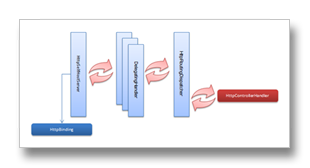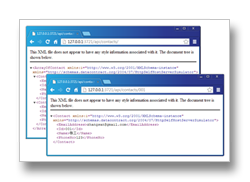ASP.NET Web API消息处理管道:Self Host下的消息处理管道[下篇]
我们知道ASP.NET Web API借助于HttpSelfHostServer以Self Host模式寄宿于当前应用程序中。而通过《上篇》的介绍我们知道Self Host下请求的监听、接收和响应是利用HttpBinding实现的,那么HttpSelfHostServer与上面介绍的HttpBinding又有何关系?HttpSelfHostServer与ASP.NET Web API的消息处理管道又是如何集成的呢?[本文已经同步到《How ASP.NET Web API Works?》]
如下面的代码片断所示,HttpSelfHostServer其实是HttpServer的子类,所以在Self Host模式下HttpSelfHostServer本身就是消息管道的组成部分。换句行话说,以HttpSelfHostServer为“龙头”的消息处理管道本身具有了请求监听、接收、处理和响应的能力。
public sealed class HttpSelfHostServer : HttpServer { public HttpSelfHostServer(HttpSelfHostConfiguration configuration); public HttpSelfHostServer(HttpSelfHostConfiguration configuration, HttpMessageHandler dispatcher); public Task OpenAsync(); public Task CloseAsync(); protected override void Dispose(bool disposing); }
Self Host模式下的消息处理管道通过创建HttpSelfHostServer时指定的HttpSelfHostConfiguration对象进行配置,其中就包括监听监听的地址。
HttpSelfHostConfiguration
如下面的代码片断所示,HttpSelfHostConfiguration直接继承自HttpConfiguration。我们在创建一个HttpSelfHostConfiguration对象的时候需要指定一个Uri对象作为监听基地址,这个地址通过只读属性BaseAddress返回。
public class HttpSelfHostConfiguration : HttpConfiguration { public HttpSelfHostConfiguration(Uri baseAddress); public Uri BaseAddress { get; } public HostNameComparisonMode HostNameComparisonMode { get; set; } public TransferMode TransferMode { get; set; } public int MaxBufferSize { get; set; } public int MaxConcurrentRequests { get; set; } public long MaxReceivedMessageSize { get; set; } public TimeSpan ReceiveTimeout { get; set; } public TimeSpan SendTimeout { get; set; } public HttpClientCredentialType ClientCredentialType { get; set; } public UserNamePasswordValidator UserNamePasswordValidator { get; set; } public X509CertificateValidator X509CertificateValidator { get; set; } }
由于Self Host模式下请求的监听、接收和响应基本上全部是通过HttpBinding实现的,所以定义在HttpSelfHostConfiguration中的众多属性实际上基本用于对创建的HttpBinding进行相应配置。从如下给出的代码片断可以看出HttpBinding类型与HttpSelfHostConfiguration具有类似的属性定义。
public abstract class Binding : IDefaultCommunicationTimeouts { //其他成员 public TimeSpan ReceiveTimeout { get; set; } public TimeSpan SendTimeout { get; set; } } public class HttpBinding : Binding, IBindingRuntimePreferences { //其他成员 public HostNameComparisonMode HostNameComparisonMode { get; set; } public TransferMode TransferMode { get; set; } public long MaxBufferPoolSize { get; set; } public int MaxBufferSize { get; set; } public long MaxReceivedMessageSize { get; set; } public HttpBindingSecurity Security { get; set; } }
由于Binding在WCF是一个核心组件,其设计本身相对复杂,要深入了解定义在HttpBinding中的这些属性需要相关的背景知识。篇幅所限,我们不能因为这些属性将Binding相关的内容全部搬过来,所以在这里我们仅仅通过如下的表格对它们进行概括性的介绍。
|
属性 |
描述 |
|
HostNameComparisonMode |
如果请求URL没有指定服务器的IP地址而是主机名称,当从URL提取主机名称后会按照相应的比较模式来最终确定匹配的主机名。该属性的类型为HostNameComparisonMode枚举,用以确定在主机名比较模式。 |
|
TransferMode |
消息传输具有两种模式,即基于Streamed和Buffered,前者以流的形式进行消息传输,后者则将整个消息的内容先保存于内存缓冲区后一并传输。该属性类型为TransferMode枚举,用以控制针对请求消息和响应消息的传输模式。在默认情况下,请求消息和响应消息均以Buffered模式进行传输。MaxBufferSize在采用Buffered模式下消息最大缓冲大小,默认值为65536(0x10000)。 |
|
MaxConcurrentRequests |
这两个是针对请求的限制,分别表示运行的最大并发访问量和请求消息允许的最大尺寸。两者的默认值分别为100和65536(0x10000)。值得一提的是:MaxConcurrentRequests针对最大并发请求的限制是针对单个处理器设定的,对于多处理器或者多核处理来说,应该乘以处理器的数量。 |
|
ReceiveTimeout |
这两个属性分别表示接收请求消息和发送响应消息的超时时限,默认值分别为10分钟和1分钟。 |
|
ClientCredentialType |
这是三个与安全认证相关的属性。ClientCredentialType表示客户端采用的用户凭证类型,而UserNamePasswordValidator和X509CertificateValidator属性值分别在用户凭证为“用户名+密码”和“X.509证书”的情况下实施认证。 |
HttpSelfHostServer与消息处理管道
在对定义的Web API采用Self Host模式寄宿时,我们会根据指定的监听基地址创建一个HttpSelfHostConfiguration对象,然后据此创建一个HttpSelfHostServer对象。当我们调用方法OpenAsync时,HttpSelfHostServer会创建一个HttpBinding对象,并根据指定的HttpSelfHostConfiguration对其作相应的设置。随后HttpBinding会针对指定的监听地址创建一个ChannelListener,并调用其BeginOpen方法以异步的方式开启。除了OpenAsync方法外,HttpSelfHostServer还定义了一个CloseAync方法使我们可以以异步的方式关闭已经开启的ChannelListener。
一旦ChannelListener被成功开启后,它便绑定到指定的监听地址进行请求的监听。一旦抵达的请求被探测到,它会利用创建的信道栈来接收该请求。通过上面对HttpBinding的介绍我们知道,接收到的二进制数据经过解码之后会生成一个HttpMessage对象,后者是对一个HttpRequestMessage的封装。
接下来HttpSelfHostServer从生成的HttpMessage中提取被封装的HttpRequestMessage对象,直接分发给消息处理管道作进一步处理。对于最终从管道传递回来的HttpResponseMessage对象,HttpSelfHostServer将其封装成一个HttpMessage对象并利用创建的信道栈返回给客户端。在通过传输层发送响应消息之前,HttpMessage会先编码。通过上面的介绍我们知道整个编码工作完全是针对被HttpMessage封装的HttpResponseMessage对象进行的,在HttpResponseMessage中保存的响应内容就是客户端接收到的内容。左图基本揭示了Self Host寄宿模式下整个消息处理管道的结构。
实例演示:创建自定义HttpServer模拟HttpSelfHostServer的工作原理
通过上面的介绍,我想读者朋友们应该对Self Host模式下消息处理管道如何进行请求的监听、接收、处理和响应已经有了全面的了解。如果我们能够创建一个自定义的HttpServer来模拟HttpSelfHostServer的工作原理,我想读者朋友们对此的印象一定更加深刻。在本章内容即将完结之前,我们就来完成这么一个演示实例。
我们通过继承HttpServer创建如下一个用于模拟HttpSelfHostServer的MyHttpSelfHostServer类型。两者对于请求的监听、接收和响应的实现原理是一致的,不同之处在于HttpSelfHostServer基本采用异步的操作方式,处于简单简洁考虑,MyHttpSelfHostServer采用同步编程方式。
public class MyHttpSelfHostServer: HttpServer { public Uri BaseAddress { get; private set; } public IChannelListener<IReplyChannel> ChannelListener { get; private set; } public MyHttpSelfHostServer(HttpConfiguration configuration, Uri baseAddress) : base(configuration) { this.BaseAddress = baseAddress; } public void Open() { HttpBinding binding = new HttpBinding(); this.ChannelListener = binding.BuildChannelListener<IReplyChannel>(this.BaseAddress); this.ChannelListener.Open(); IReplyChannel channnel = this.ChannelListener.AcceptChannel(); channnel.Open(); while (true) { RequestContext requestContext = channnel.ReceiveRequest(TimeSpan.MaxValue); Message message = requestContext.RequestMessage; MethodInfo method = message.GetType().GetMethod("GetHttpRequestMessage"); HttpRequestMessage request = (HttpRequestMessage)method.Invoke(message, new object[] {true}); Task<HttpResponseMessage> processResponse = base.SendAsync(request, new CancellationTokenSource().Token); processResponse.ContinueWith(task => { string httpMessageTypeName = "System.Web.Http.SelfHost.Channels.HttpMessage, System.Web.Http.SelfHost"; Type httpMessageType = Type.GetType(httpMessageTypeName); Message reply = (Message)Activator.CreateInstance( httpMessageType, new object[] { task.Result }); requestContext.Reply(reply); }); } } public void Close() { if (null != this.ChannelListener && this.ChannelListener.State == CommunicationState.Opened) { this.ChannelListener.Close(); } } }
MyHttpSelfHostServer的只读属性BaseAddress表示监听基地址,该属性直接在构造函数中指定。与HttpSelfHostServer不同的是,用于创建MyHttpSelfHostServer提供的配置对象是一个HttpConfiguration对象而不再是HttpSelfHostConfiguration。
在Open方法中,我们根据提供的监听基地址利用HttpBinding对象创建一个ChannelListener对象,MyHttpSelfHostServer的只读属性ChannelListener引用的也正是这个对象。在开启该ChannelListener之后,我们调用其AccpetChannel方法创建信道栈,最终返回位于栈顶的Channel。在该Channel开启的情况下,我们在一个“永不终止”的While循环中调用其ReceiveRequest方法进行请求的监听。
当信道栈成功接收请求消息后(通过前面的介绍我们知道这是一个HttpMessage对象),我们从中提取出被封装的HttpRequestMessage对象,并将其作为参数调用SendAsync方法,表示请求的HttpReuqestMessage自此进入了消息处理管道这个流水车间。
调用SendAsync方法返回的是一个Task<HttpResponseMessage>对象,我们对此作这样的后续操作:提供作为响应消息的HttpResponseMessage对象,并通过反射的形式将其封装成HttpMessage对象,最终将此对象通过信道栈对请求予以最终的响应。
HttpSelfHostServer定义了OpenAsync和CloseAsync方法开启和关闭监听器,与之相匹配,我们也为Open方法定义了匹配的Close方法来关闭已经开启的ChannelListener。
为了验证我们自定义的MyHttpSelfHostServer是否能够替代“原生”的HttpSelfHostServer,我们在一个控制台中定义了如下一个ContactsController。它具有两个重载的Action方法Get,前者用于返回所有的联系人列表,后者返回指定ID的某个联系人信息。
public class ContactsController : ApiController { private static List<Contact> contacts = new List<Contact> { new Contact{ Id="001", Name = "张三", PhoneNo="123", EmailAddress="zhangsan@gmail.com"}, new Contact{ Id="002", Name = "李四", PhoneNo="456", EmailAddress="lisi@gmail.com"} }; public IEnumerable<Contact> Get() { return contacts; } public Contact Get(string id) { return contacts.FirstOrDefault(c => c.Id == id); } } public class Contact { public string Id { get; set; } public string Name { get; set; } public string PhoneNo { get; set; } public string EmailAddress { get; set; } }
在作为入口的Main方法中我们编写了如下一段简单的“寄宿”程序。我们根据创建的HttpConfiguration对象和指定的监听基地址(“http://127.0.0.1:3721”)创建了一个MyHttpSelfHostServer对象。在调用Open方法开始监听之前,我们注册了一个URL模板为“http://127.0.0.1:3721”的HttpRoute。
class Program { static void Main(string[] args) { using (MyHttpSelfHostServer httpServer = new MyHttpSelfHostServer( new HttpConfiguration(), new Uri("http://127.0.0.1:3721"))) { httpServer.Configuration.Routes.MapHttpRoute( name : "DefaultApi", routeTemplate : "api/{controller}/{id}", defaults : new { id = RouteParameter.Optional }); httpServer.Open(); Console.Read(); } } }
运行该程序之后,这个“宿主”程序便开始进行请求的监听。现在我们直接利用浏览器对定义在ContactsController中的两个Action方法Get发起请求,通过注册的HttpRoute和请求的HTTP方法直接作为Action名称的原理,我们使用的URL分别为“http://127.0.0.1:3721/api/contacts”和“http://127.0.0.1:3721/api/contacts/001”。如右图所示,我们期望的联系人信息直接以XML的形式显示在浏览器中,由此可见我们自定义的MyHttpSelfHostServer“不辱使命”。

